One‑Pot Greek Lentils
One-Pot Greek Lentils: A Hearty, Healthy, and Flavorful Mediterranean Classic
Looking for a wholesome, plant-based meal that’s as comforting as it is nutritious? One-Pot Greek Lentils are the answer. This traditional Mediterranean dish combines earthy lentils with aromatic herbs, tangy tomatoes, and a hint of lemon to create a satisfying meal that’s simple to prepare and rich in flavor. Whether you’re cooking for one or feeding a family, this one-pot wonder delivers on taste, texture, and ease—perfect for weeknight dinners, meal prep, or impressing guests with minimal effort.
The History of Greek Lentils
Lentils have been a cornerstone of Greek cuisine for thousands of years, dating back to ancient times when they were a staple food for both commoners and philosophers alike. In fact, historical accounts suggest that Pythagoras, the famous mathematician and philosopher from ancient Greece, was known to follow a vegetarian diet heavily based on legumes, including lentils. The island of Fakas (which literally means “lentils” in Greek) in the Aegean Sea is said to be named after the legume due to its abundance there.
Greek lentils, particularly those grown in the region of Papingo in Epirus, are renowned for their small size, tender texture, and rich, nutty flavor. Unlike larger green or brown lentils that may require pre-soaking, these tiny lentils hold their shape beautifully during cooking and absorb flavors effortlessly, making them ideal for stews and one-pot meals.
This humble legume has long symbolized sustenance, simplicity, and nourishment in Greek culture. Traditionally served during Lent and religious fasting periods (when meat is avoided), Greek lentil dishes like Fakes Soupa or Fakes Krasates (wine-braised lentils) remain popular across households and tavernas. Over time, regional variations have emerged, incorporating local herbs, vegetables, and wine, but the essence remains unchanged: a hearty, healthy, and deeply flavorful dish rooted in tradition.
Ingredients Breakdown
The beauty of One-Pot Greek Lentils lies in its simplicity and the harmony of fresh, wholesome ingredients. Each component plays a vital role in building layers of flavor and nutrition:
- Dry Green or Brown Lentils (or Puy-style): About 1 cup. These hold their shape well and offer a peppery, earthy flavor. Avoid red lentils, as they turn mushy.
- Extra Virgin Olive Oil: 3 tablespoons. A hallmark of Mediterranean cooking, it adds richness and helps sauté aromatics.
- Yellow Onion: 1 large, finely chopped. Provides sweetness and depth.
- Carrots: 2 medium, diced. Add natural sweetness and color.
- Celery: 2 stalks, diced. Contributes a subtle herbal note and texture.
- Garlic: 4 cloves, minced. Essential for aromatic depth.
- Tomato Paste: 2 tablespoons. Concentrated umami and acidity to enhance the broth.
- Diced Canned Tomatoes: 1 can (14 oz). Adds tanginess and body to the stew.
- Dried Oregano: 1 tablespoon. A quintessential Greek herb with warm, slightly floral notes.
- Dried Thyme: 1 teaspoon. Complements oregano with an earthy, minty undertone.
- Fresh Bay Leaf: 1 leaf. Imparts a subtle woodsy aroma (remove before serving).
- Vegetable Broth or Water: 4 cups. Using broth enhances flavor; water works in a pinch.
- Lemon Juice: Juice of 1 large lemon. Brightens the entire dish and balances richness.
- Salt and Black Pepper: To taste. Season gradually for balanced flavor.
- Optional Garnishes: Fresh parsley, crumbled feta cheese, a drizzle of olive oil, or a dollop of Greek yogurt.
All ingredients are typically pantry- or fridge-stable, making this recipe accessible year-round and adaptable to seasonal availability.
Step-by-Step Recipe
- Rinse the Lentils: Place 1 cup of dry lentils in a fine-mesh strainer. Rinse thoroughly under cold water, removing any debris or shriveled lentils. Set aside to drain.
- Sauté the Aromatics: In a large heavy-bottomed pot or Dutch oven, heat 3 tablespoons of extra virgin olive oil over medium heat. Add the chopped onion, carrots, and celery. Cook for 6–8 minutes, stirring occasionally, until softened and lightly golden.
- Add Garlic and Herbs: Stir in the minced garlic, dried oregano, thyme, and bay leaf. Cook for 1 minute until fragrant—be careful not to burn the garlic.
- Incorporate Tomato Paste: Push the vegetables to one side and add the tomato paste to the center of the pot. Let it cook undisturbed for 30 seconds, then stir into the vegetables. This step deepens the flavor through caramelization.
- Add Tomatoes and Lentils: Pour in the canned diced tomatoes (with juices) and stir to combine. Add the rinsed lentils and mix well to coat with the tomato and oil mixture.
- Pour in Liquid: Add 4 cups of vegetable broth or water. Stir well, scraping the bottom of the pot to release any stuck bits (this is flavor!). Increase heat to bring the mixture to a gentle boil.
- Simmer Until Tender: Reduce heat to low, cover the pot with a lid, and let it simmer gently for 35–45 minutes. Stir occasionally to prevent sticking. The lentils are done when tender but still hold their shape—avoid overcooking into mush.
- Season and Finish: Remove the bay leaf. Stir in the fresh lemon juice. Taste and season generously with salt and freshly ground black pepper. Remember: lemon enhances seasoning, so adjust after adding juice.
- Rest Before Serving: Turn off the heat and let the lentils sit, covered, for 10 minutes. This allows flavors to meld and the texture to settle.
- Serve: Ladle into bowls and garnish with chopped fresh parsley, a sprinkle of feta cheese, and a final drizzle of high-quality olive oil if desired.
Tips for Perfect One-Pot Greek Lentils
- Don’t Skip the Sauté: Taking time to properly sweat the onions, carrots, and celery builds a rich flavor base (known as a sofrito or vasilopita in Greek cooking).
- Use Good-Quality Olive Oil: Since this is a key ingredient, opt for a fruity, robust extra virgin olive oil—it makes a noticeable difference.
- Acid at the End: Always add lemon juice just before serving. Cooking it too early can dull its brightness.
- Watch the Salt: If using store-bought broth, it may already contain salt. Start with less and adjust at the end.
- Avoid Stirring Too Much: While occasional stirring is fine, excessive agitation can break down lentils. Let them cook undisturbed when possible.
- Soaking Is Optional: Unlike beans, lentils don’t need soaking, but a quick 30-minute soak can reduce cooking time slightly and improve digestibility.
- Cook Covered: Keeping the pot covered retains moisture and ensures even cooking. If the stew gets too thick, add a splash of hot water or broth.
- Let It Rest: Allowing the lentils to rest off the heat lets them absorb remaining liquid and intensifies flavor absorption.
Variations and Customizations
One of the greatest strengths of this recipe is its versatility. Here are several creative twists to suit different tastes and dietary needs:
- Wine-Infused Version: Add ½ cup of dry red wine after sautéing the vegetables. Let it reduce by half before adding tomatoes and lentils—adds depth and complexity reminiscent of Fakes Krasates.
- Spicy Kick: Add a pinch of red pepper flakes or a chopped fresh chili with the garlic for heat.
- Smoky Flavor: Stir in ½ teaspoon smoked paprika or a small piece of kombu seaweed while cooking for umami and smokiness (great for vegan “meaty” depth).
- With Greens: Stir in 2 cups of chopped kale, spinach, or Swiss chard during the last 10 minutes of cooking for added nutrients and color.
- Protein Boost: Add crumbled cooked sausage, shredded chicken, or diced tofu for extra protein.
- Herb Swaps: Try marjoram, rosemary, or dill instead of oregano for a different aromatic profile.
- Coconut Twist: Replace 1 cup of broth with light coconut milk for a creamy, subtly sweet variation inspired by fusion cuisine.
- Grain-Enhanced: Serve over quinoa, brown rice, or orzo pasta to make it a more filling main course.
- Vegan & Gluten-Free: This recipe is naturally gluten-free and vegan as written—just ensure broth and garnishes comply.
Health Considerations and Nutritional Value
One-Pot Greek Lentils aren’t just delicious—they’re a nutritional powerhouse. Here’s why this dish deserves a regular spot in your meal rotation:
- High in Plant-Based Protein: Lentils provide about 18g of protein per cooked cup, making them excellent for vegetarians and vegans.
- Rich in Fiber: With around 15g of fiber per cup, they support digestive health, regulate blood sugar, and promote satiety.
- Heart-Healthy Fats: Olive oil contributes monounsaturated fats, which are linked to reduced inflammation and improved cholesterol levels.
- Packed with Micronutrients: Lentils are high in iron, folate, manganese, phosphorus, and B vitamins—essential for energy metabolism and red blood cell production.
- Low Glycemic Index: They release glucose slowly, helping maintain stable energy levels and making them suitable for diabetics.
- Antioxidant-Rich: Tomatoes and olive oil contain lycopene and polyphenols, powerful antioxidants that combat oxidative stress.
- Supports Gut Health: The combination of fiber and fermented garnishes like yogurt or olives promotes a healthy microbiome.
- Low in Calories, High in Volume: At approximately 300–350 calories per serving (without garnishes), it’s ideal for weight management.
Note: Some people may experience gas or bloating from lentils due to oligosaccharides. Rinsing well, cooking thoroughly, and adding herbs like oregano or a strip of kombu during cooking can improve digestibility.
Ingredients
- 1 cup dry green or brown lentils (Puy-style preferred)
- 3 tbsp extra virgin olive oil
- 1 large yellow onion, finely chopped
- 2 medium carrots, diced
- 2 celery stalks, diced
- 4 garlic cloves, minced
- 2 tbsp tomato paste
- 1 (14 oz) can diced tomatoes, undrained
- 1 tbsp dried oregano
- 1 tsp dried thyme
- 1 fresh bay leaf
- 4 cups vegetable broth or water
- Juice of 1 large lemon (about ¼ cup)
- Salt and freshly ground black pepper, to taste
- Fresh parsley, chopped (for garnish)
- Crumbled feta cheese (optional, for serving)
- Additional olive oil (for drizzling)
Directions
- Rinse lentils under cold water and drain.
- In a large pot, heat olive oil over medium heat. Add onion, carrots, and celery. Cook 6–8 minutes until soft.
- Add garlic, oregano, thyme, and bay leaf. Cook 1 minute until fragrant.
- Push veggies aside, add tomato paste to center. Cook 30 seconds, then stir in.
- Stir in diced tomatoes and lentils. Mix well.
- Pour in broth or water. Stir, scraping the bottom of the pot.
- Bring to a boil, then reduce heat to low. Cover and simmer 35–45 minutes, until lentils are tender.
- Remove bay leaf. Stir in lemon juice.
- Season with salt and pepper to taste.
- Let rest 10 minutes before serving.
- Garnish with parsley, feta, and a drizzle of olive oil if desired.
FAQ
Can I use canned lentils?
Yes, though flavor and texture will differ. Use 2–3 cans (drained and rinsed) and reduce cooking time to 15–20 minutes just to heat through and blend flavors.
How long do leftovers last?
Store in an airtight container in the refrigerator for up to 5 days. Flavors deepen over time!
Can I freeze Greek lentils?
Absolutely. Cool completely and freeze for up to 3 months. Thaw overnight in the fridge and reheat on the stove with a splash of water.
Why are my lentils mushy?
Overcooking or using red/yellow lentils (which break down easily) can cause mushiness. Stick to green or brown varieties and check tenderness starting at 30 minutes.
Is this recipe gluten-free?
Yes, as long as you use gluten-free certified broth and ensure all other ingredients are GF-safe.
Can I make it in a slow cooker or Instant Pot?
Slow Cooker: Sauté veggies first, then transfer to cooker with all ingredients except lemon. Cook on Low 6–8 hours or High 3–4 hours. Add lemon before serving.
Instant Pot: Use Sauté function for veggies, then add all ingredients except lemon. Pressure cook on High for 15 minutes, natural release 10 minutes. Stir in lemon juice.
What to serve with Greek lentils?
Excellent with crusty bread, pita, Greek salad, roasted vegetables, or a side of tzatziki. Also great as a filling for wraps or stuffed tomatoes.
Summary
One-Pot Greek Lentils are a nourishing, flavorful, and easy-to-make Mediterranean dish that celebrates simple ingredients and timeless tradition. Packed with protein, fiber, and heart-healthy fats, this stew is as good for your body as it is for your soul.






